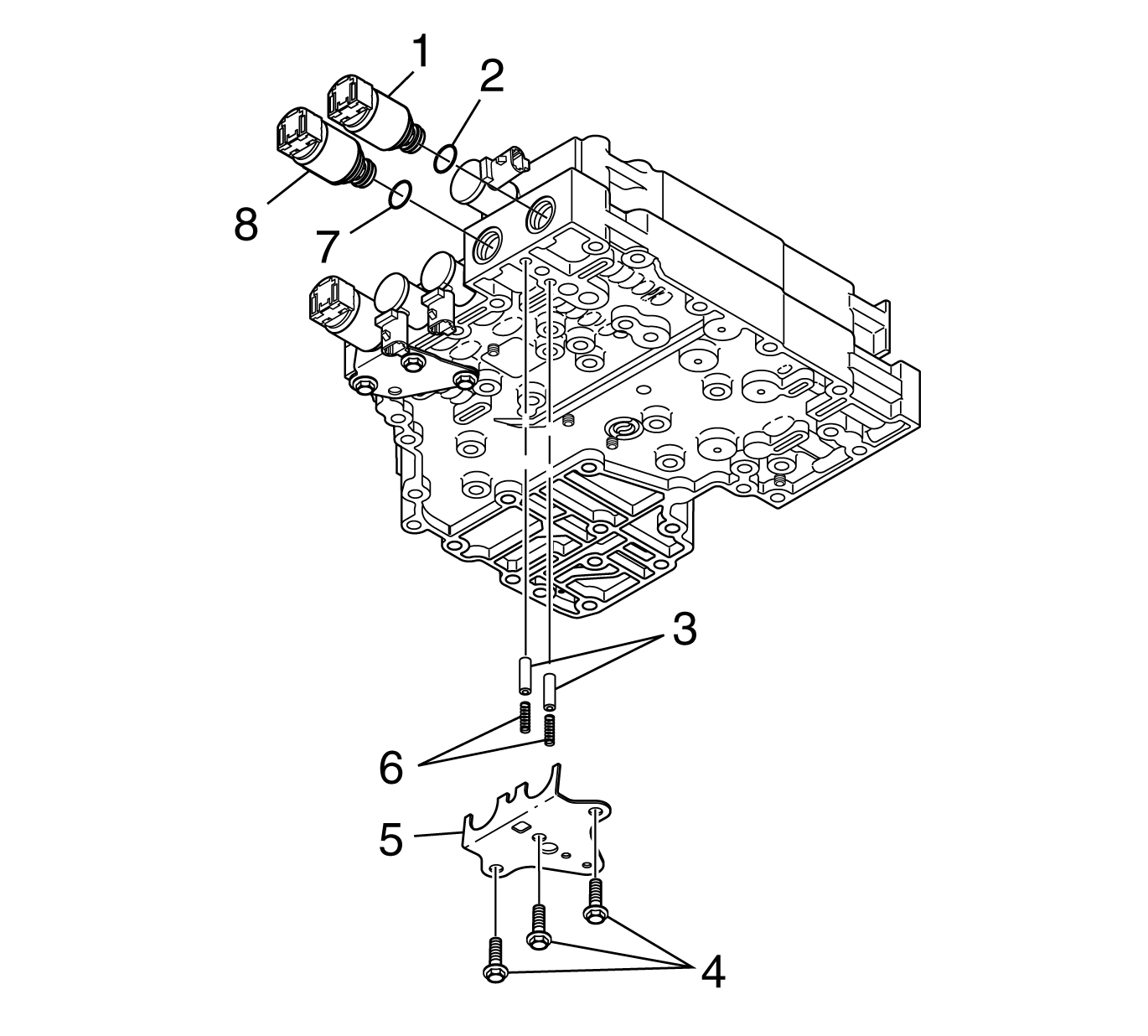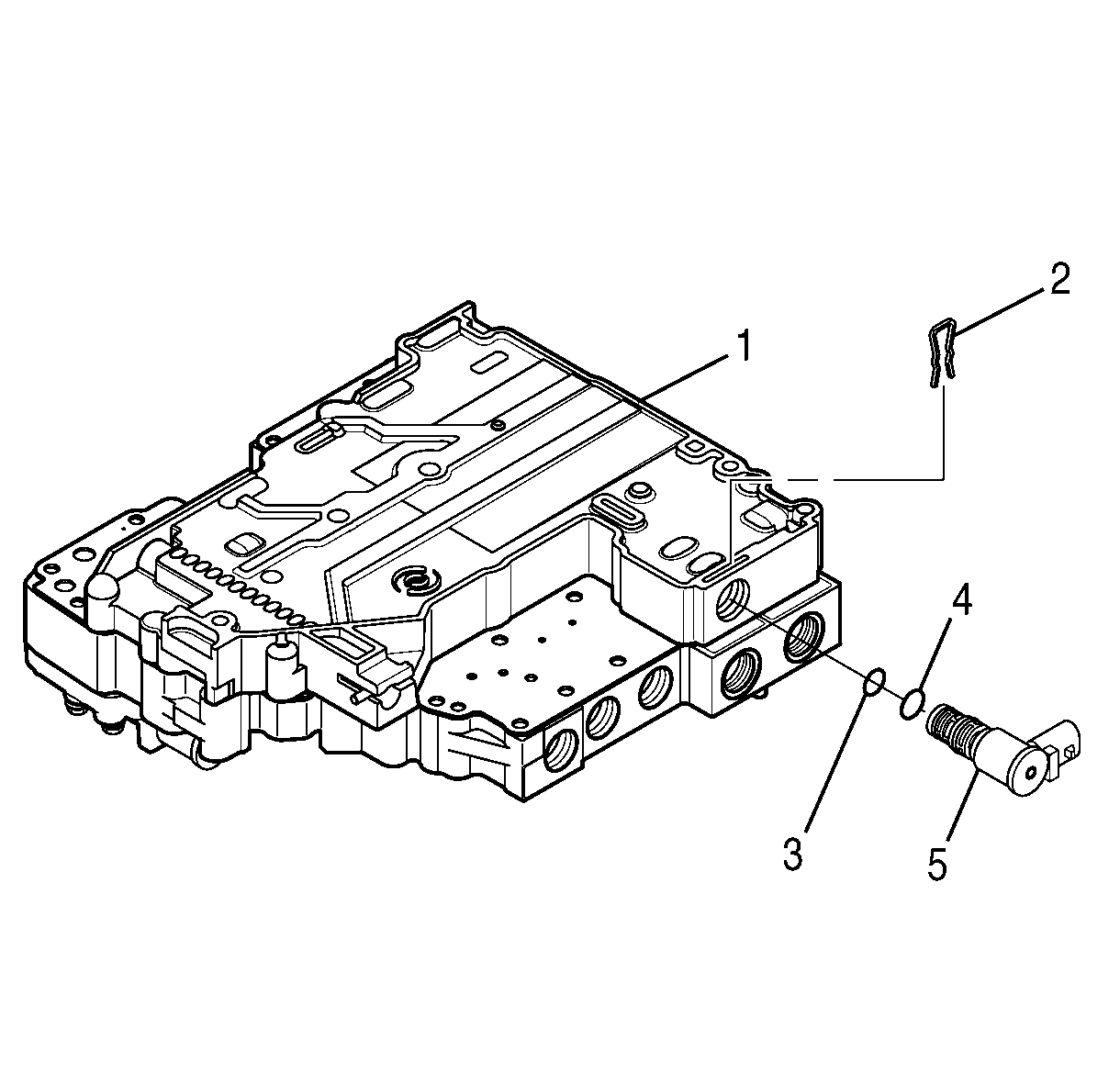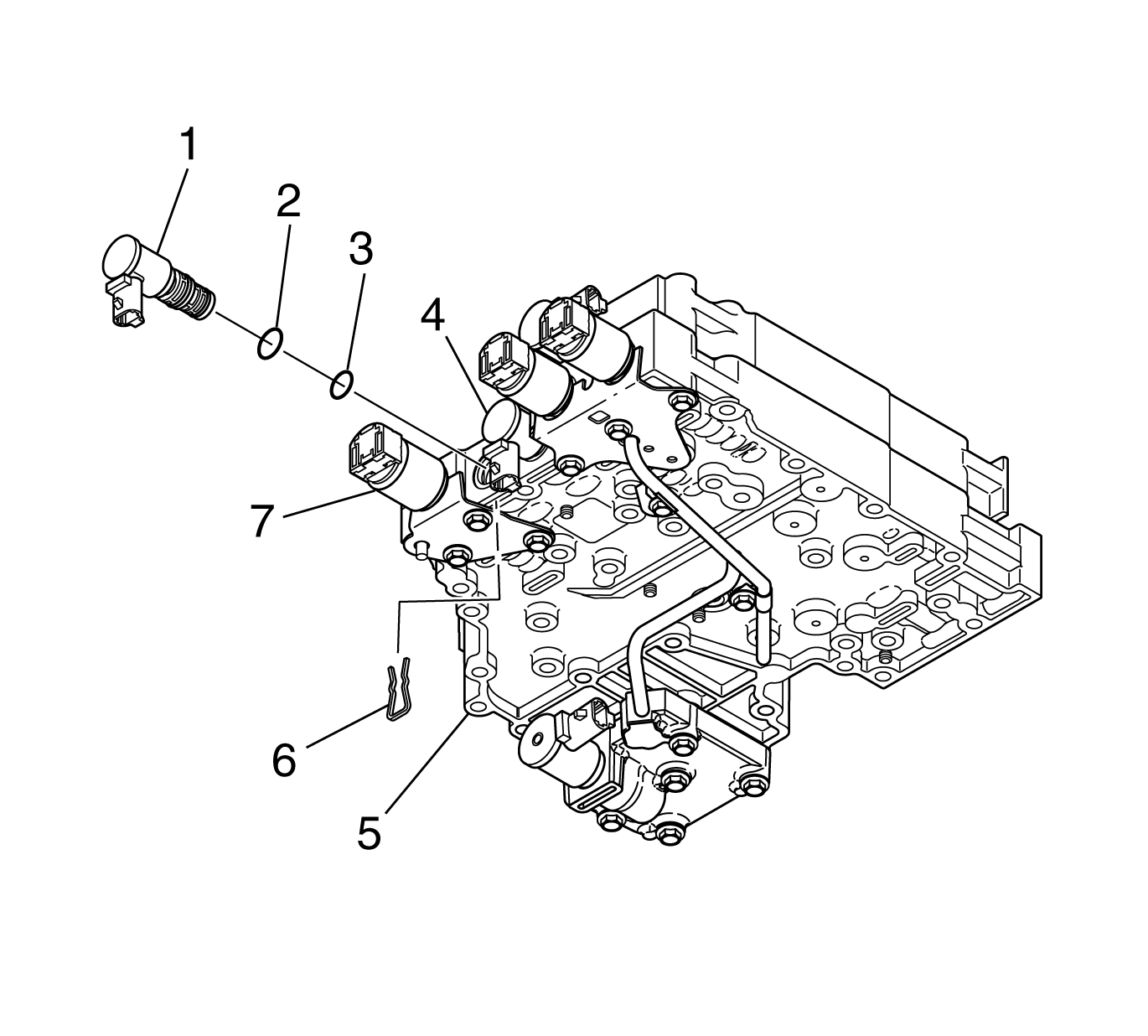Control Valve Solenoid Replacement PCS1 and PCS2
Removal Procedure
- Remove the oil pan and transmission internal oil filter. Refer to Oil Pan Replacement.
- Disconnect the internal wiring harness from the solenoid being changed.
- Remove the 2 bolts that fasten reverse signal pipe (1) to the control valve assembly. Remove the reverse signal pipe.
- To remove the pressure control solenoid 1 (PCS1) or PCS2, remove three bolts (4) and the pressure control valve retaining bracket (5). Remove accumulators (3) and springs (6) if they do not fall out when the bracket (5) is removed.
- Note the position of the solenoid connector and pull the solenoid (1) or (8) out of the bore in the control valve assembly. The O-ring on the solenoid provides the resistance felt during removal.


Important:
• When the pressure control valve retaining bracket (5) is removed, there are 2 sets of accumulators (3) and springs (6) which may fall from the bores. Be sure to catch the accumulators and springs so as to prevent damage to these
parts. • The pressure control valve retaining bracket (5) must not be modified. Note that the angle between the 2 bracket surfaces is less than 90 degrees. Replace the bracket if the angle is 90 degrees or more.
Installation Procedure
- Obtain the new solenoid (1) or (8). Lubricate new O-ring (2) or (7) with clean transmission fluid. Install the O-ring and push the new solenoid into the control valve body bore with the wiring harness connector in the correct position.
- Install the 2 accumulators (3) and springs (6) before installing the pressure control valve retaining bracket (5). The valve (3) goes in the bore first with the hollow end facing outward, followed by the spring (6) which goes inside the hollow portion of the valve.
- Install the pressure control valve retaining bracket (5), and install the 3 bolts (4).
- Install the reverse signal pipe (1). Install the 2 bolts that fasten reverse signal pipe to the control valve assembly.
- Reconnect the internal wiring harness to the solenoid.
- Install the oil pan and transmission internal oil filter. Refer to Oil Pan Replacement.
- Perform the FastLearn procedure. Refer to FastLearn Procedure.

Notice: Use the correct fastener in the correct location. Replacement fasteners must be the correct part number for that application. Fasteners requiring replacement or fasteners requiring the use of thread locking compound or sealant are identified in the service procedure. Do not use paints, lubricants, or corrosion inhibitors on fasteners or fastener joint surfaces unless specified. These coatings affect fastener torque and joint clamping force and may damage the fastener. Use the correct tightening sequence and specifications when installing fasteners in order to avoid damage to parts and systems.
Tighten
Tighten the bolts to 12 N·m (108 lb in).

Tighten
Tighten the bolts to 12 N·m (108 lb in).
Important: The FastLearn, adapt, procedure must be performed. This can be done in 1 step using a scan tool. If this procedure is not done, the TCM adaptive values will be at the settings that it learned for the old components and will be in slow adaptive mode. Under these conditions, it will take an unacceptably long time for the adaptive values to converge to levels suitable for the new transmission.
Control Valve Solenoid Replacement SS1, SS2, SS3, TCC, and MAIN MOD
Removal Procedure
- Remove the oil pan and the transmission internal oil filter. Refer to Oil Pan Replacement .
- Disconnect the internal wiring harness from the solenoid being changed.
- Remove the solenoid retainer (2) for shift solenoid 1 (SS1) (5). Note the position of the solenoid connector and pull the solenoid (5) out of the bore in the control valve assembly (1). The O-rings (3 and 4) provide the resistance felt during removal.
- Remove the solenoid retainer (6) for shift solenoid 2 (SS2) (1) or shift solenoid 3 (SS3) (4), whichever is being replaced.
- Note the position of the solenoid connector and pull the solenoid out of the bore in the control valve assembly. The O-rings (2 and 3) provide the resistance felt during removal.
- Remove the TCC PCS retaining bolt and retaining bracket.
- Remove the TCC PCS (7).


Important: The TCC pressure control solenoid (PCS) retaining bracket must not be modified. Note that the angle between the 2 bracket surfaces is less than 90 degrees. Replace the bracket if the angle is 90 degrees or greater.
Installation Procedure
- Obtain a new SS 2 (1), SS 3 (4), TCC PCS (7), or modulated main pressure solenoid. Install O-rings (2 and 3) and lubricate with clean transmission fluid. Push the new solenoid into the control valve assembly (5) with the wiring harness connector in the correct position.
- Install the solenoid retainer (6). Connect the internal wiring harness to the solenoids replaced.
- For a new TCC PCS (7), install O-rings and lubricate with clean transmission fluid. Push the new TCC PCS (7) into the control valve assembly with the wiring harness connector in the correct position.
- Install the TCC PCS retainer and bolt.
- For a new SS 1 (5), install O-rings (3 and 4) and lubricate with clean transmission fluid. Push the new SS 1 (5) into the control valve assembly with the wiring harness connector in the correct position. Install the solenoid retainer (2).
- Install the oil pan and transmission internal oil filter. Refer to Oil Pan Replacement .
- Perform the FastLearn procedure. Refer to FastLearn Procedure .

Tighten
Tighten the bolt to 12 N·m (108 lb in).

Important: The FastLearn, adapt, procedure must be performed. This can be done in 1 step using a scan tool. If this procedure is not done, the TCM adaptive values will be at the settings that it learned for the old components and will be in slow adaptive mode. Under these conditions, it will take an unacceptably long time for the adaptive values to converge to levels suitable for the new transmission.
